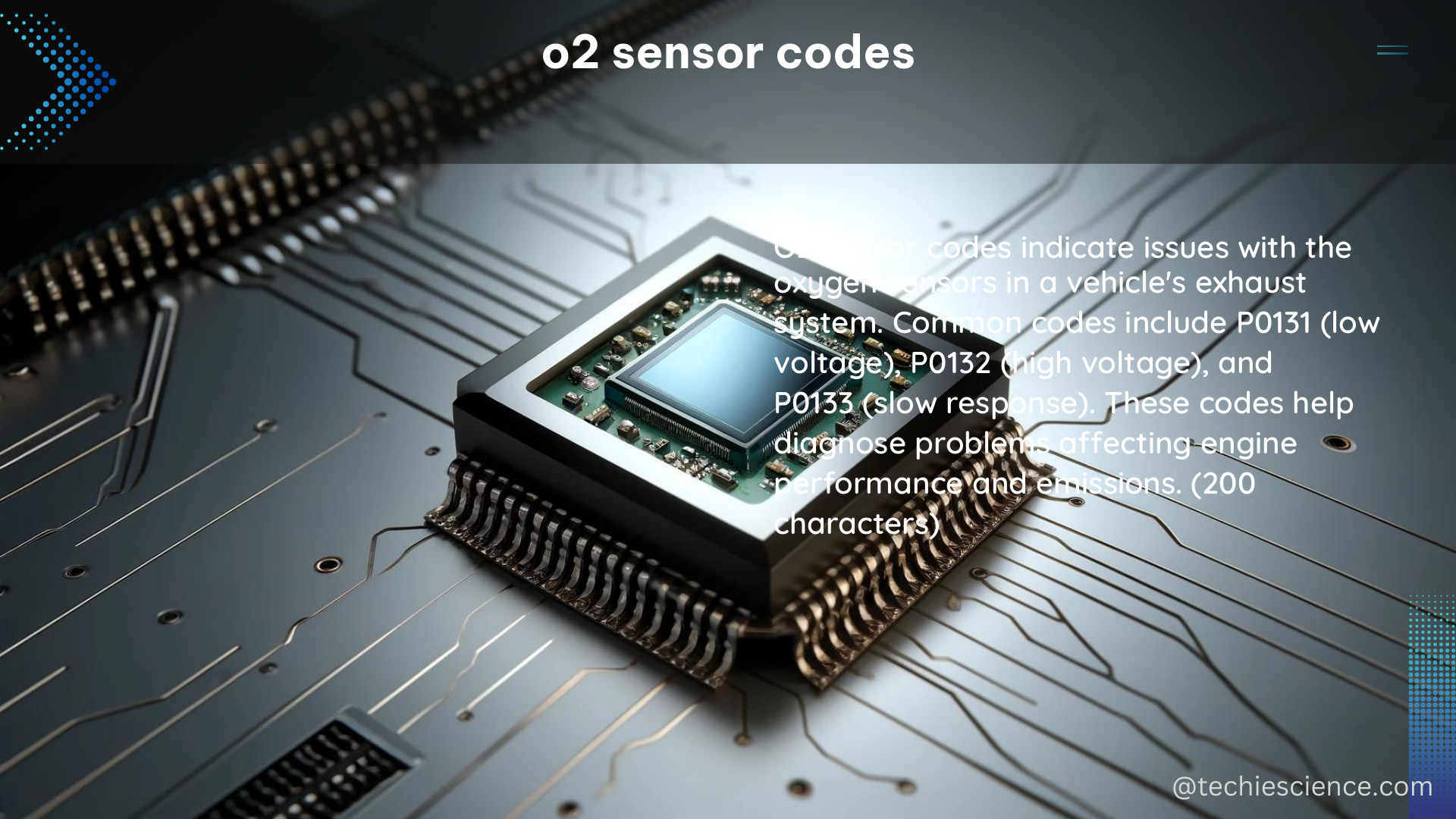O2 sensor codes, also known as oxygen sensor fault codes, are diagnostic trouble codes (DTCs) that indicate issues with the oxygen sensors in a vehicle’s exhaust system. These sensors play a crucial role in monitoring the air-fuel mixture and emissions control, and understanding their technical specifications and calibration requirements is essential for effective diagnosis and repair.
Understanding O2 Sensor Codes
O2 sensor codes are typically in the format of “P0xxx,” where the “P” stands for “powertrain” and the following digits provide more specific information about the issue. Some common O2 sensor codes include:
- P0130: O2 Sensor Circuit Malfunction (Bank 1, Sensor 1)
- P0135: O2 Sensor Heater Circuit Malfunction (Bank 1, Sensor 1)
- P0155: O2 Sensor Heater Circuit Malfunction (Bank 2, Sensor 1)
- P0171: System Too Lean (Bank 1)
- P0174: System Too Lean (Bank 2)
These codes can indicate a wide range of issues, from faulty oxygen sensors to problems with the engine’s air-fuel mixture or exhaust system.
Oxygen Sensor Specifications and Calibration

To effectively diagnose and repair O2 sensor issues, it’s crucial to understand the technical specifications and calibration requirements of these sensors. According to the EPA’s Air Quality Criteria for Carbon Monoxide, the following guidelines should be followed:
Multipoint Calibration
- A multipoint calibration at five or six different CO concentrations covering the operating range of the analyzer is recommended for high-sensitivity measurement.
- This calibration can be accomplished by diluting a known high-concentration CO standard gas with zero gas in a calibrated flow dilution system.
Secondary Calibration
- Secondary calibration consists of a zero and upscale span of the analyzer, which should be performed daily.
- If the analyzer response differs by more than 2% from the certified concentrations, the analyzer should be adjusted accordingly.
- Complete records of secondary calibrations should be kept for data reduction and auditing purposes.
Data Processing and Checks
- For accurate and precise CO measurements, data processing, control sample, and water vapor interference checks should be performed by a qualified individual independent of the regular operator.
- Guidelines have been published by the EPA for calculating an overall bias and standard deviation of errors associated with data processing, measurement of control samples, and water vapor interference, from which the accuracy and precision of CO measurements can be determined.
- Since January 1, 1983, all state and local agencies submitting data to the EPA must provide estimates of accuracy and precision of the CO measurements based on primary and secondary calibration records.
Diagnosing and Repairing O2 Sensor Issues
When an O2 sensor malfunctions or fails, it can trigger a check engine light and generate an O2 sensor code. To diagnose and repair these issues, follow these steps:
-
Scan for Codes: Use an OBD-II scanner to read the diagnostic trouble codes (DTCs) stored in the vehicle’s computer. This will provide a starting point for your diagnosis.
-
Inspect the Sensor: Visually inspect the O2 sensor for signs of damage, such as a cracked or corroded sensor element, damaged wiring, or loose connections.
-
Test the Sensor: Use a multimeter to test the sensor’s voltage output and resistance. Refer to the manufacturer’s specifications to ensure the sensor is operating within the acceptable range.
-
Check the Wiring and Connections: Inspect the wiring harness and connections between the O2 sensor and the vehicle’s computer. Look for signs of damage, corrosion, or loose connections.
-
Perform a Sensor Replacement: If the sensor is faulty, replace it with a new one that meets the manufacturer’s specifications. Be sure to follow the proper installation procedures to ensure a secure and reliable connection.
-
Clear the Codes and Test Drive: After replacing the sensor, clear the diagnostic trouble codes and take the vehicle for a test drive. Monitor the check engine light and scan for any new codes that may indicate additional issues.
By understanding the technical specifications and calibration requirements of O2 sensors, as well as the proper diagnostic and repair procedures, you can effectively address O2 sensor codes and maintain your vehicle’s performance and emissions control.
References:
- U.S. Environmental Protection Agency. Air Quality Criteria for Carbon Monoxide. EPA-454/R-02-003. 2002.
- Hydrogen Program. Analysis, Codes and Standards – 2023. 2023.
- Liu, M. Content Ontology Design Patterns Qualities, Methods, and Tools. 2018.
- DOE Office of Science. Topics – DOE Office of Science – OSTI.GOV. 2024.
- Sensor Technology Handbook. OLLINTEC. 2016.

The lambdageeks.com Core SME Team is a group of experienced subject matter experts from diverse scientific and technical fields including Physics, Chemistry, Technology,Electronics & Electrical Engineering, Automotive, Mechanical Engineering. Our team collaborates to create high-quality, well-researched articles on a wide range of science and technology topics for the lambdageeks.com website.
All Our Senior SME are having more than 7 Years of experience in the respective fields . They are either Working Industry Professionals or assocaited With different Universities. Refer Our Authors Page to get to know About our Core SMEs.